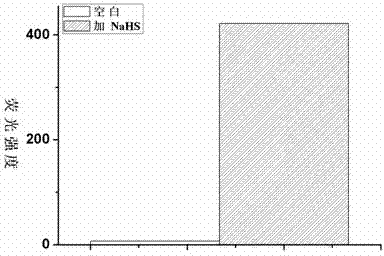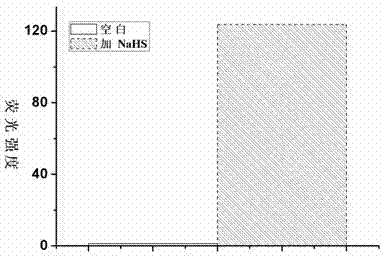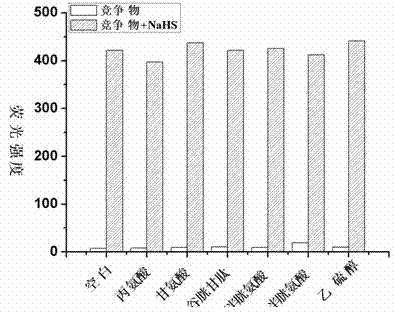A kind of azo fluorescent probe for detecting biological hydrogen sulfide and its application
A fluorescent probe and azo-based technology, applied in the field of fluorescent probes for the detection of biological hydrogen sulfide, can solve the problems of large detection errors and achieve the effects of avoiding interference, high detection signal-to-noise ratio, and excellent selectivity
- Summary
- Abstract
- Description
- Claims
- Application Information
AI Technical Summary
Problems solved by technology
Method used
Image
Examples
Embodiment 1
[0015] Embodiment 1: the probe molecule shown in following formula II and H 2 Fluorescence changes before and after S reaction
[0016]
[0017] Dissolve the probe molecule with a small amount of ethanol, and add PBS buffer or NaHS in PBS solution respectively, so that the final concentration of the probe molecule is 20 μM, and the final concentration of NaHS is 500 μM. After reacting for 1.0 hour, measure on the fluorescence spectrometer, and then determine the probe molecule and H 2 After the S reaction, the fluorescence intensity was significantly enhanced, and the results can be found in figure 1 .
Embodiment 2
[0018] Embodiment 2: the probe molecule shown in following formula III and H 2 Fluorescence changes before and after S reaction
[0019]
[0020] Dissolve the probe molecule with a small amount of ethanol, and add PBS buffer or NaHS in PBS solution respectively, so that the final concentration of the probe molecule is 20 μM, and the final concentration of NaHS is 500 μM. After reacting for 1.0 hour, measure on the fluorescence spectrometer, and then determine the probe molecule and H 2 After the S reaction, the fluorescence intensity was significantly enhanced, and the results can be found in figure 2 .
Embodiment 3
[0021] Example 3: Probe molecule II to H 2 S selectivity
[0022] Dissolve the probe molecules with a small amount of ethanol, and then use PBS buffer to form a solution. The samples to be tested dissolved in PBS buffer were respectively added, so that the final concentration of the probe molecule was 20 μM, and the concentration of the sample to be tested was 500 μM. After reacting for 1.0 hour, measure on the fluorescence spectrometer, and then determine the probe molecule pair H 2 S selectivity. See results image 3 , the probe molecule pair H 2 S is highly selective.
PUM
| Property | Measurement | Unit |
|---|---|---|
| emission peak | aaaaa | aaaaa |
Abstract
Description
Claims
Application Information
 Login to View More
Login to View More - R&D
- Intellectual Property
- Life Sciences
- Materials
- Tech Scout
- Unparalleled Data Quality
- Higher Quality Content
- 60% Fewer Hallucinations
Browse by: Latest US Patents, China's latest patents, Technical Efficacy Thesaurus, Application Domain, Technology Topic, Popular Technical Reports.
© 2025 PatSnap. All rights reserved.Legal|Privacy policy|Modern Slavery Act Transparency Statement|Sitemap|About US| Contact US: help@patsnap.com



